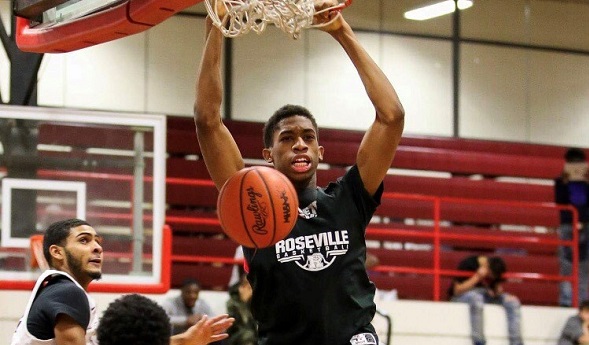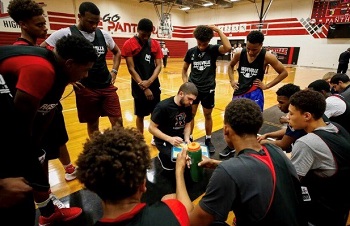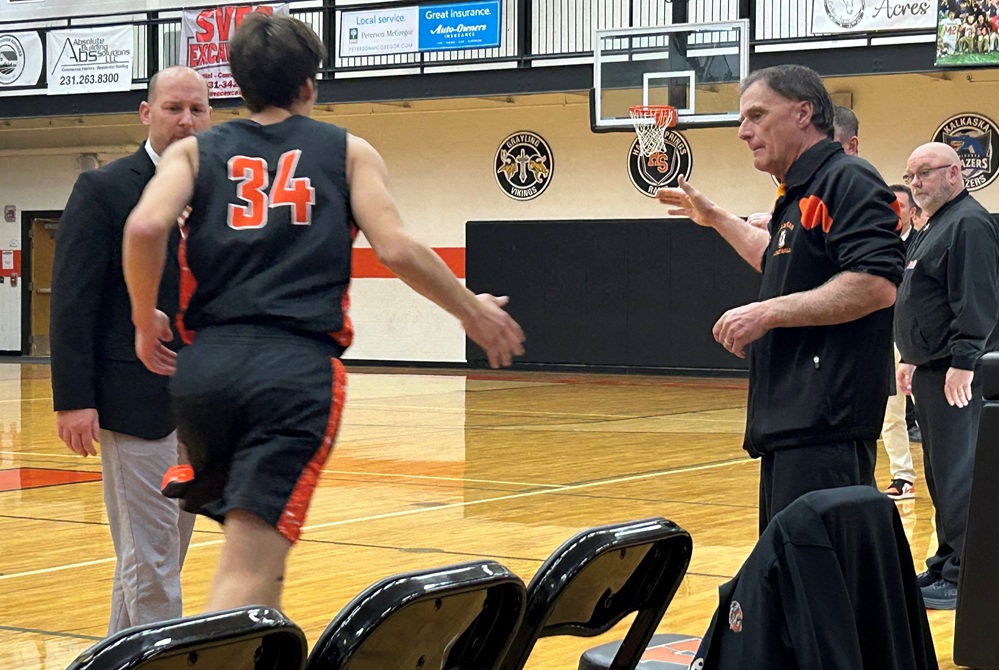
New Reality has Roseville Dreaming Big
By
Tom Markowski
Special for Second Half
January 30, 2019
ROSEVILLE – Something happened last February that produced a dramatic effect on the Roseville boys basketball team.
 It’s difficult for Roseville coach Hassan Nizam to put into words – but he’s certain that his team’s trip to Ann Arbor to play Pioneer and, more importantly, their visit to the Crisler Center to watch a University of Michigan practice had a positive impact on last year’s team and the program as a whole.
It’s difficult for Roseville coach Hassan Nizam to put into words – but he’s certain that his team’s trip to Ann Arbor to play Pioneer and, more importantly, their visit to the Crisler Center to watch a University of Michigan practice had a positive impact on last year’s team and the program as a whole.
“(The U-M staff) gave us a tour,” Nizam said. “It was eye-opening. There was something about it. I can’t even explain it. We’ve lost twice since. Maybe it turned them into dreamers.”
Roseville won seven straight after losing that game to Pioneer before a 44-39 defeat to Macomb Dakota in a Class A Regional Semifinal ended the Panthers’ season.
They’ve stormed back this winter and sit 13-1 entering the final month of the regular season, with their only loss coming at Dakota, 55-52, in the fifth game. Roseville avenged that loss with a 63-56 victory at home Jan. 15 and is ranked No. 3 in Division 1 in the latest Associated Press poll.
The Panthers are 8-1 in the Macomb Area Conference Red and have clinched a share of the title. They can win it outright with a victory at Sterling Heights Stevenson on Monday.
After that and over the next two months, Roseville is shaping up as a possibility to not only make school history, but carry its entire area into an elite scenario for the first time.
Teams from Macomb County have rarely been relevant come tournament time. Not only has a Macomb County team never won a Class A (now Division 1) title, the county has never been represented in a Class A Final in boys basketball. Warren DeLaSalle made the Class B Final in 1982 and has come close to breaking that county barrier, reaching Class A Semifinals in 1986, 2007 and last season. Dakota also lost in the Class A Semifinals in 2016.
Enter Roseville. The program has had limited success in the MHSAA Tournament – last season the Panthers finished 16-7 and won just the fourth District title in program history. They’ve never won a Regional.
Talent has come through in the past, but didn’t always guarantee a postseason run. Sir’Dominic Pointer (known as Dominick Pointer while attending Roseville) played two seasons at Roseville before transferring to a prep school in North Carolina, then played collegiately at St. John’s and was selected as the 53rd pick in the 2015 NBA Draft by Cleveland. He is currently playing professionally in Israel. Still, Roseville was not able to get past the District round in either of his seasons.
But on the positive side, this team is coming off that District title and has plenty of experience to go with ability. Four starters are back including seniors Darien Banks, Lazell Judge and John Ukomadu. The other returning start is junior point guard Martell Turner who, if he isn’t the team’s best, is likely the team’s most important player. The fifth starter is senior Deshaun Wright.
At 24, Nizam is one of the state’s youngest head coaches and his upbeat coaching style has had a rippling effect. This attitude impressed those who were responsible for hiring him, notably school principal Pat Adams.
“Our search for a new coach was centered on someone who loved kids and was passionate about the game,” Adams said. “In Coach Niz, we struck gold on both accounts. A big part of changing the culture in a building is to have the kids believe in themselves, feel pride in who they represent, and respect the leaders who spend time with them. We believe Coach Niz has demonstrated that he's a very important part of that formula and will continue to be as the program evolves.”
A 2012 graduate of Dearborn Fordson, Nizam spent three seasons as the junior varsity and varsity assistant at Fordson before becoming an assistant at U-M Dearborn for the 2016-17 season. Nizam said one of his first objectives when he was hired at Roseville in May of 2017 was to build consistency.
 “I was just an assistant coach looking for an opportunity,” he said. “As far as the program here, I knew they had had some success. The transition was pretty smooth, and the kids bought in. (Sir’)Dominic stops by every now and then, and the kids appreciate that. The guys have to understand that individual success comes from team success.”
“I was just an assistant coach looking for an opportunity,” he said. “As far as the program here, I knew they had had some success. The transition was pretty smooth, and the kids bought in. (Sir’)Dominic stops by every now and then, and the kids appreciate that. The guys have to understand that individual success comes from team success.”
Last season was one of the most successful in school history. As a member of the MAC White, Roseville competed in the MAC Red/White division playoffs and defeated Clinton Township Chippewa Valley for the title. Two weeks later, Roseville won the District title by defeating St. Clair Shores Lake Shore 80-77.
Roseville opted to move up to the MAC Red this season, and one result is a more competitive schedule. In addition to the increase in competition the Red affords, the Panthers defeated DeLaSalle to open the winter, then defeated Division 2 contender New Haven at New Haven and slipped past Cincinnati Withrow (Ohio), 42-39, at the Motor City Roundball Classic.
“We kind of have the approach that we want to get better each game,” Nizam said. “We’ve got a chance to win the MAC Red, the MAC title, a District title and a Regional. It’s that day-to-day thing we like to emphasize.”
What makes this team better than last season’s is Roseville’s play on the defensive end. The players are communicating better, switching assignments when teams run a motion offense and playing help defense.
In Roseville’s 65-60 victory over New Haven, the Panthers held Romeo Weems – New Haven’s best player and a likely candidate for the Mr. Basketball Award – to 20 points. As a team, Roseville has allowed 45 points per game. And just one team, New Haven, has scored in the 60s.
“That New Haven game was big for us,” Nizam said. “They hadn’t lost a game at home in like six years. We weren’t going to let Weems beat us. Our kids believed in each other that game. After that, their confidence went way up. It showed we can be a problem for any team.”
Offensively, Roseville likes to score in transition, but its half-court sets have improved since last season as well. Banks is an accurate 3-point shooter and leads the team in scoring at 21 points per game. Turner is the table-setter who averages seven assists. Ukomadu is a 6-foot-7 post player who jumps well, and Judge is a 6-1 lefty who plays the wing.
Wright is a 6-3 power forward who possesses a good mid-range jump shot. And he’s one example of why the program has shown promise and is on the rise. Wright never played high school basketball before this season. He played basketball in middle school before concentrating on football his first three years of high school.
Wright saw the success the team had last season and, in the end, it was Nizam’s coaching style that won him over.
“I caught a few games at the end of last year,” Wright said. “I liked (Nizam’s) enthusiasm. He wants to win as much as we do. He wants it just as bad as we do. My mom (Ruth Wright) told me, to be a two-sport athlete coming out of high school would help me in college. I would love to play either one in college.”
Wright has yet to decide on which school he will attend next fall, and he is expected to take a visit to Urbana University in Ohio before making his decision.
In the meantime, Wright’s focus is on his teammates and continuing what they together have started.
“Once we step on the floor, we’re connected,” he said. “Our goal is to get better every game.
“Sharpen the ax. And we are getting better every day. I know by the way we compete against each other in practice.”
 Tom Markowski is a correspondent for the State Champs! Sports Network and previously directed its web coverage. He also covered primarily high school sports for the The Detroit News from 1984-2014, focusing on the Detroit area and contributing to statewide coverage of football and basketball. Contact him at [email protected] with story ideas for Oakland, Macomb and Wayne counties.
Tom Markowski is a correspondent for the State Champs! Sports Network and previously directed its web coverage. He also covered primarily high school sports for the The Detroit News from 1984-2014, focusing on the Detroit area and contributing to statewide coverage of football and basketball. Contact him at [email protected] with story ideas for Oakland, Macomb and Wayne counties.
PHOTOS: (Top) Roseville’s John Ukomadu throws down a dunk during a scrimmage. (Middle) Panthers players huddle with coach Hassan Nizam. (Photos by Brian Sevald Photo.)

'Scott Hancock Court' Celebrates JV Coach's 50 Years Building Up Cheboygan Hoops
By
Tom Spencer
Special for MHSAA.com
December 19, 2025
It’s been a remarkable season so far for the Cheboygan boys basketball players and coaches.
 The undefeated varsity Chiefs are looking ahead to the new calendar year and their next opponent, Northern Shores Conference rival Elk Rapids. They also have the District tournament they’ll be hosting in February in their sights.
The undefeated varsity Chiefs are looking ahead to the new calendar year and their next opponent, Northern Shores Conference rival Elk Rapids. They also have the District tournament they’ll be hosting in February in their sights.
But Scott Hancock is already looking ahead to the classes of 2035, 2036, 2037 and 2038. And nobody can blame him.
Hancock, a 1976 graduate of Cheboygan, has no intentions of ending his coaching career soon. He’d like to make it long enough to coach his youngest grandson Lincoln Hancock, who is already playing youth basketball in Cheboygan.
And while the Chiefs are finding success this year with the foundation Hancock helped build, the veteran coach can’t help but dream about his youngest grandson playing at Cheboygan High School.
“As a kindergartner he’s in Saturday basketball, and he loves the game,” Hancock said. “God willing, I plan to be there for him.”
Hancock is his 50th season in Cheboygan program. He enjoyed the opportunity to coach his two sons Nick and Brian, both school record holders. He’s also enjoyed coaching his grandson, Landon Gahn, the Chiefs’ junior point guard. Gahn played junior varsity for Hancock his freshman year and moved up to the varsity his sophomore season.
All but two of Hancock’s season were spent as the JV coach. He took the varsity job on an interim basis when current Cheboygan varsity coach, Jason Friday, was playing for the Chiefs in the late 1990s.
On Dec. 9, the Chiefs officially named their home court the Scott Hancock Court. His family was on hand as well as current and former Northern Michigan coaches.
Hancock’s JV team lost that night to Alpena in overtime. The score was 50-50 when the fourth quarter buzzer sounded.
“Looking back, we should have just called the game at the end of regulation,” Hancock admitted. “I got a bunch of great kids this year. and it was a tough loss because it was an overtime loss.”
 It was the only loss the Chiefs’ JV team has encountered so far this year. But wins and losses are not the focus of Hancock’s level of the program.
It was the only loss the Chiefs’ JV team has encountered so far this year. But wins and losses are not the focus of Hancock’s level of the program.
“I don't get too carried away with the wins and losses — I know what I'm there for,” Hancock explained. “I'm there to teach the kids to get them ready for the varsity.”
Hancock is considered by many to be the best coach in Cheboygan history. No counter argument can be found among the current varsity players and their head coach.
“He's the best coach that I've ever had — no bias because he's my grandfather,” acknowledged Gahn, who was found cheering from the bench as the Chiefs secured the victory earlier this week at Kingsley. “He teaches everything about basketball, but he doesn't really preach as much as he demonstrates being a good person. Just looking at him and what he does every day, you can just tell he's the guy that's doing everything right, even though nobody's watching.”
Senior Carson Kiefer helped lead the way for Cheboygan's varsity at Kingsley. He scored 12 points, with two 3-pointers. Kiefer credits Hancock for helping him improve his confidence on the court.
“I think he cares more about the person individually outside of sports,” said Kiefer, who is averaging 16 points per game. “It's fitting that he's a JV basketball coach, helping build players’ skills and confidence.”
Kiefer’s twin brother, Andrew, singled out Hancock’s commitment to the school.
“He's not just a school figure,” said Andrew Kiefer, who is averaging just under 12 points per game. “He is not just the coach. He is a community guy all-around.”
The Chiefs varsity is getting strong contributions from their juniors this season. Nolan Schley is averaging 12 points per game, and he’s second on the team in rebounding. And Gavin Smith is leading the team in rebounds and assists, collecting almost 10 boards and four dishes per game.
The Kiefers, Smith and Schley are part of the reason Friday is not surprised by the 6-0 start and seeking a District title for the first time since 2015. The last time Cheboygan won a conference championship was 2020, playing in the Straits Area Conference during Friday’s first season as boys head coach after previously coaching the girls varsity.
 “We knew that our junior and senior classes had some talent in there,” Friday noted. “The boys really want to win a District championship, as well as a conference championship. The boys put a ton of time in the offseason to do everything they can to get over that hump and get both a conference and District championship.”
“We knew that our junior and senior classes had some talent in there,” Friday noted. “The boys really want to win a District championship, as well as a conference championship. The boys put a ton of time in the offseason to do everything they can to get over that hump and get both a conference and District championship.”
Cheboygan will host a Division 2 District tournament this season after falling 50-48 in last year’s Division 3 District Final – also at home. The Chiefs face a field including league foes Grayling, Kalkaska and Kingsley as well as Ogemaw Heights and Sault Ste. Marie. Cheboygan topped the Sault 67-43 earlier this year and will play a home-and-home series with Grayling in January.
For now, though, the Chiefs are thinking only about Elk Rapids. Cheboygan started 7-0 last year before falling to the Elks to start the new year.
“We're approaching 7-0 again, so having them coming up here on the schedule, we’re definitely going to be practicing a little harder and watching maybe a little more film and just preparing for the game more seriously,” Gahn said. “Coach Friday was saying last year that he can't remember the last time the team started off 8-0, and it was our eighth game that we lost to Elks. So we're hoping to beat them next time we play.”
The court naming did not come as a surprise to Hancock. He was informed in a meeting with Marty Mix, Cheboygan principal. He thought he had some papers to sign and was surprised his family was waiting in the office.
“He was completely shocked, and Coach Hancock doesn't like attention,” said Friday, who is also the school’s athletic director and was in the notification meeting. “Scott always likes to be in the background, and he handled it quite well.”
And while his signature was placed on the court opening day this year, he points out the Hancock legacy started way before him.
“I'm more proud of the Hancock name on there more than the Scott part of it,” said Hancock, who also serves as the city’s as the parks and recreation director. “Believe me, my dad was a Chief through and through. He passed in 2006. I know he was there in spirit with us looking down.”
 Tom Spencer is a longtime MHSAA-registered basketball and soccer official, and former softball and baseball official, and he also has coached in the northern Lower Peninsula area. He previously has written for the Saginaw News, Bay County Sports Page and Midland Daily News. He can be reached at [email protected] with story ideas for Manistee, Wexford, Missaukee, Roscommon, Ogemaw, Iosco, Alcona, Oscoda, Crawford, Kalkaska, Grand Traverse, Benzie, Leelanau, Antrim, Otsego, Montmorency, Alpena, Presque Isle, Cheboygan, Charlevoix and Emmet counties.
Tom Spencer is a longtime MHSAA-registered basketball and soccer official, and former softball and baseball official, and he also has coached in the northern Lower Peninsula area. He previously has written for the Saginaw News, Bay County Sports Page and Midland Daily News. He can be reached at [email protected] with story ideas for Manistee, Wexford, Missaukee, Roscommon, Ogemaw, Iosco, Alcona, Oscoda, Crawford, Kalkaska, Grand Traverse, Benzie, Leelanau, Antrim, Otsego, Montmorency, Alpena, Presque Isle, Cheboygan, Charlevoix and Emmet counties.
PHOTOS (Top) Longtime Cheboygan boys basketball JV coach Scott Hancock sends a starter onto the floor during introductions before a game against Kingsley. (Middle) The Hancock family takes a photo with Scott’s newly-added signature on the floor. From left: Landon Gahn, Brian Hancock, Olwyn Hancock, Scott Hancock, Marjean Hancock, Lincoln Hancock and Nick Hancock. (Below) Scott Hancock shakes hands with a Kingsley assistant coach. (Family photo courtesy of Chris Murdick. Other photos by Tom Spencer.)

